Contractual Procedures & Procurement for Construction Project Analysis
VerifiedAdded on 2020/07/23
|11
|3456
|119
Report
AI Summary
This report provides a comprehensive analysis of contractual procedures and procurement within the Hong Kong construction sector, focusing on a hi-tech commercial building project undertaken by Build Project Construction Private Limited. The report delves into the implications of being ahead of or behind schedule using Earned Value Management (EVM) and schedule variance analysis, comparing project costs across pre-contract, tender, and final accounting stages. It evaluates contractual measures to ensure contractor compliance with quality requirements, referencing the HKSAR GCC 1999. The report further analyzes contractual agreements for nominated, named, and other types of subcontractors, along with contractual arrangements used with suppliers, providing insights into the legalities, procurement processes, and roles of involved parties. The report emphasizes the importance of effective contract administration and cost control throughout the project lifecycle, offering practical examples and references to relevant clauses within the HKSAR GCC 1999 to ensure adherence to standards.
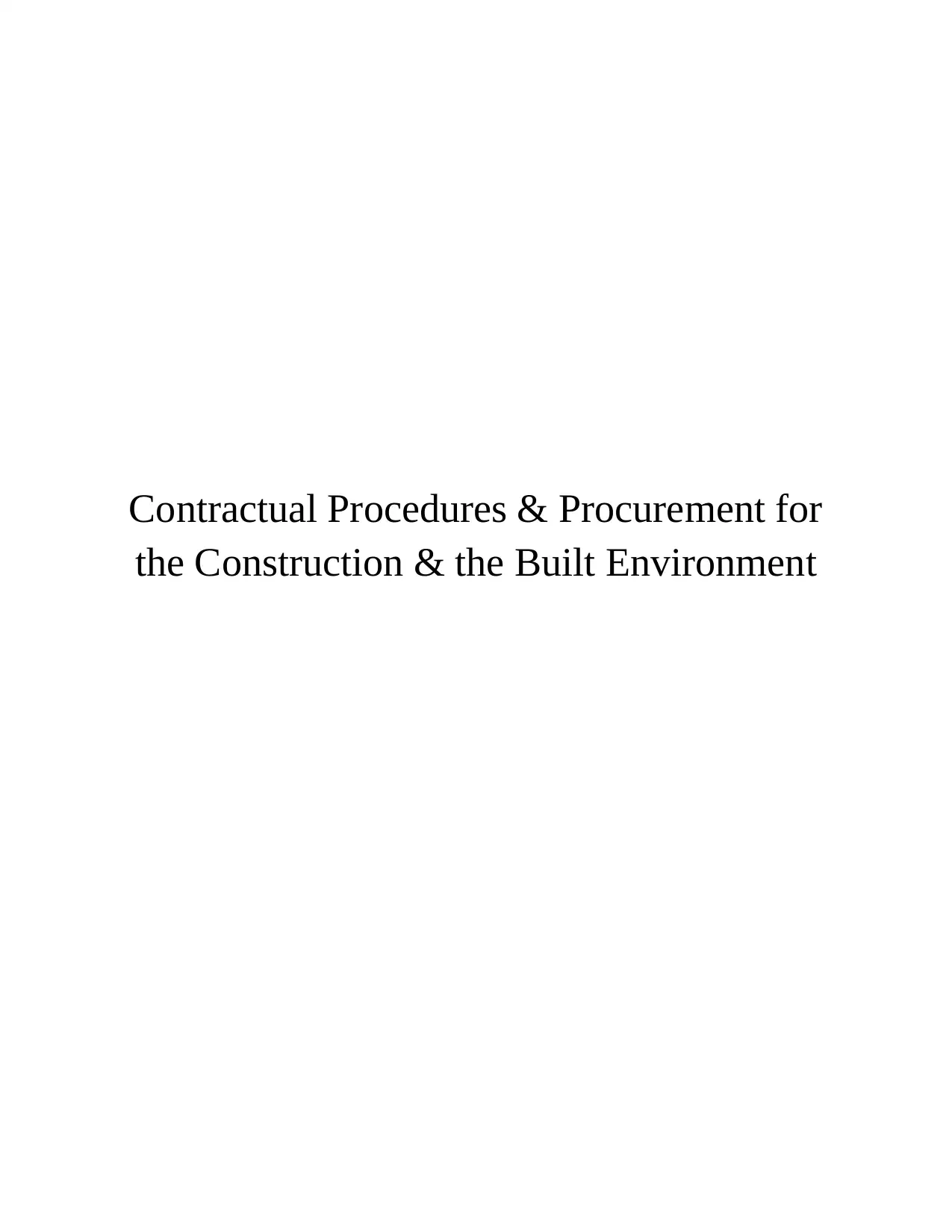
Contractual Procedures & Procurement for
the Construction & the Built Environment
the Construction & the Built Environment
Paraphrase This Document
Need a fresh take? Get an instant paraphrase of this document with our AI Paraphraser

Table of Contents
INTRODUCTION.........................................................................................................................................1
PART 1 GENERAL CONTRACT ADMINISTRATION............................................................................1
4.1 Explaining the implications of being ahead of or behind schedule for completion.............................1
4.2 Comparing the project costs regarding pre-contract, tender and final accounting stage.....................3
4.3 Evaluating contractual measures or provisions to ensure contractor’s work compliance with quality
requirements...............................................................................................................................................4
5.1 Analyze and describe current contractual agreements for nominated, named & other type of
subcontractors............................................................................................................................................5
5.2 Evaluate the types of contractual arrangements used with suppliers...................................................6
CONCLUSION..............................................................................................................................................7
REFERENCES..............................................................................................................................................8
INTRODUCTION.........................................................................................................................................1
PART 1 GENERAL CONTRACT ADMINISTRATION............................................................................1
4.1 Explaining the implications of being ahead of or behind schedule for completion.............................1
4.2 Comparing the project costs regarding pre-contract, tender and final accounting stage.....................3
4.3 Evaluating contractual measures or provisions to ensure contractor’s work compliance with quality
requirements...............................................................................................................................................4
5.1 Analyze and describe current contractual agreements for nominated, named & other type of
subcontractors............................................................................................................................................5
5.2 Evaluate the types of contractual arrangements used with suppliers...................................................6
CONCLUSION..............................................................................................................................................7
REFERENCES..............................................................................................................................................8

INTRODUCTION
Hong Kong Construction sector has gained a well reputation in the economy by rapid
construction of high-quality apartments, buildings and commercial buildings. According to the
recent economical report, it earned a gross value of HK 4.2 $ million (Building and construction
industry in Hong Kong, 2016). The constructors are using modern techniques i.e. reclamation,
design & build and other methods. The industry classified construction activities into three
categories i.e. commercial, residential and industrial. Build Project Construction Private Limited
is an experienced general contractor in HK who called tenders for the proposed construction
project of a hi-tech commercial building in Central. The report here aims at analyzing the
legalities, procurement process, techniques & roles and responsibilities of the parties engaged in
contractual procedure. The report lay emphasizes upon addressing pre and post contract
administration issues for the completion of proposed building construction under General
Conditions of Contract for Building Works (GCC), 1999.
PART 1 GENERAL CONTRACT ADMINISTRATION
4.1 Explaining the implications of being ahead of or behind schedule for completion
The fundamental principle of Earned Value Management (EVM) is that the value of work
completed must be exactly equal to the budgeted amount (Fleming and Koppelman, 2016)
Earned value schedule variance analysis identifies that whether a project is ahead of or behind
the schedule for the completion purpose. Schedule variance (SV) compares and analyzes the
difference between work completed with the planned or proposed schedule (Wang and et.al.,
2016). It is computed by subtracting the earned value with the planned value of the project by
Build Project, can be stated as follows:
SV = EV – PV
Here, positive variances reflects that project is ahead of schedule means if Build Project
exceeds the earned value of the project by the proposed or planned value then it tells that the
construction work of hi-tech commercial building is ahead of its designed schedule (Tsang and
et.al., 2017). Alternatively, completion of work before the actual date targeted or decided
1
Hong Kong Construction sector has gained a well reputation in the economy by rapid
construction of high-quality apartments, buildings and commercial buildings. According to the
recent economical report, it earned a gross value of HK 4.2 $ million (Building and construction
industry in Hong Kong, 2016). The constructors are using modern techniques i.e. reclamation,
design & build and other methods. The industry classified construction activities into three
categories i.e. commercial, residential and industrial. Build Project Construction Private Limited
is an experienced general contractor in HK who called tenders for the proposed construction
project of a hi-tech commercial building in Central. The report here aims at analyzing the
legalities, procurement process, techniques & roles and responsibilities of the parties engaged in
contractual procedure. The report lay emphasizes upon addressing pre and post contract
administration issues for the completion of proposed building construction under General
Conditions of Contract for Building Works (GCC), 1999.
PART 1 GENERAL CONTRACT ADMINISTRATION
4.1 Explaining the implications of being ahead of or behind schedule for completion
The fundamental principle of Earned Value Management (EVM) is that the value of work
completed must be exactly equal to the budgeted amount (Fleming and Koppelman, 2016)
Earned value schedule variance analysis identifies that whether a project is ahead of or behind
the schedule for the completion purpose. Schedule variance (SV) compares and analyzes the
difference between work completed with the planned or proposed schedule (Wang and et.al.,
2016). It is computed by subtracting the earned value with the planned value of the project by
Build Project, can be stated as follows:
SV = EV – PV
Here, positive variances reflects that project is ahead of schedule means if Build Project
exceeds the earned value of the project by the proposed or planned value then it tells that the
construction work of hi-tech commercial building is ahead of its designed schedule (Tsang and
et.al., 2017). Alternatively, completion of work before the actual date targeted or decided
1
⊘ This is a preview!⊘
Do you want full access?
Subscribe today to unlock all pages.

Trusted by 1+ million students worldwide
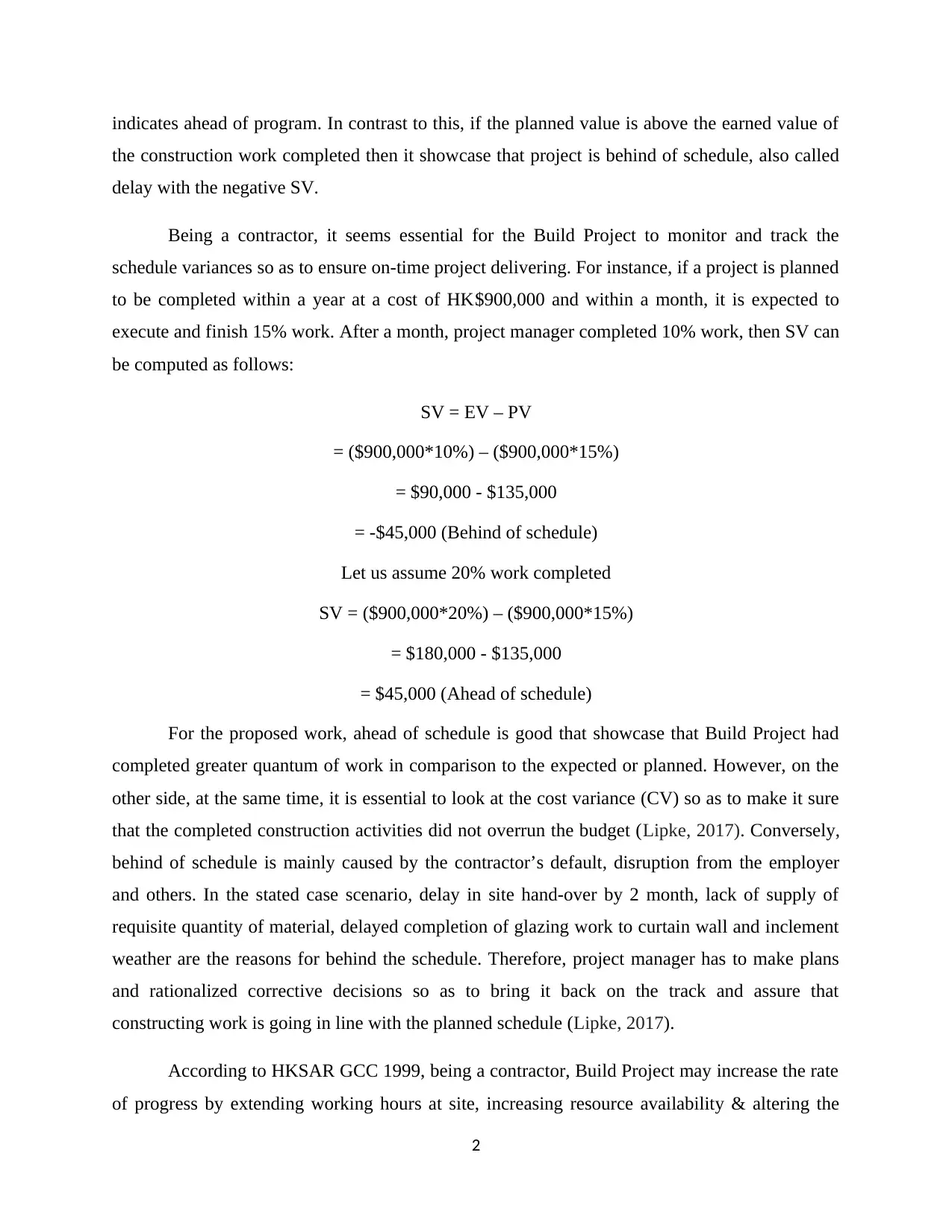
indicates ahead of program. In contrast to this, if the planned value is above the earned value of
the construction work completed then it showcase that project is behind of schedule, also called
delay with the negative SV.
Being a contractor, it seems essential for the Build Project to monitor and track the
schedule variances so as to ensure on-time project delivering. For instance, if a project is planned
to be completed within a year at a cost of HK$900,000 and within a month, it is expected to
execute and finish 15% work. After a month, project manager completed 10% work, then SV can
be computed as follows:
SV = EV – PV
= ($900,000*10%) – ($900,000*15%)
= $90,000 - $135,000
= -$45,000 (Behind of schedule)
Let us assume 20% work completed
SV = ($900,000*20%) – ($900,000*15%)
= $180,000 - $135,000
= $45,000 (Ahead of schedule)
For the proposed work, ahead of schedule is good that showcase that Build Project had
completed greater quantum of work in comparison to the expected or planned. However, on the
other side, at the same time, it is essential to look at the cost variance (CV) so as to make it sure
that the completed construction activities did not overrun the budget (Lipke, 2017). Conversely,
behind of schedule is mainly caused by the contractor’s default, disruption from the employer
and others. In the stated case scenario, delay in site hand-over by 2 month, lack of supply of
requisite quantity of material, delayed completion of glazing work to curtain wall and inclement
weather are the reasons for behind the schedule. Therefore, project manager has to make plans
and rationalized corrective decisions so as to bring it back on the track and assure that
constructing work is going in line with the planned schedule (Lipke, 2017).
According to HKSAR GCC 1999, being a contractor, Build Project may increase the rate
of progress by extending working hours at site, increasing resource availability & altering the
2
the construction work completed then it showcase that project is behind of schedule, also called
delay with the negative SV.
Being a contractor, it seems essential for the Build Project to monitor and track the
schedule variances so as to ensure on-time project delivering. For instance, if a project is planned
to be completed within a year at a cost of HK$900,000 and within a month, it is expected to
execute and finish 15% work. After a month, project manager completed 10% work, then SV can
be computed as follows:
SV = EV – PV
= ($900,000*10%) – ($900,000*15%)
= $90,000 - $135,000
= -$45,000 (Behind of schedule)
Let us assume 20% work completed
SV = ($900,000*20%) – ($900,000*15%)
= $180,000 - $135,000
= $45,000 (Ahead of schedule)
For the proposed work, ahead of schedule is good that showcase that Build Project had
completed greater quantum of work in comparison to the expected or planned. However, on the
other side, at the same time, it is essential to look at the cost variance (CV) so as to make it sure
that the completed construction activities did not overrun the budget (Lipke, 2017). Conversely,
behind of schedule is mainly caused by the contractor’s default, disruption from the employer
and others. In the stated case scenario, delay in site hand-over by 2 month, lack of supply of
requisite quantity of material, delayed completion of glazing work to curtain wall and inclement
weather are the reasons for behind the schedule. Therefore, project manager has to make plans
and rationalized corrective decisions so as to bring it back on the track and assure that
constructing work is going in line with the planned schedule (Lipke, 2017).
According to HKSAR GCC 1999, being a contractor, Build Project may increase the rate
of progress by extending working hours at site, increasing resource availability & altering the
2
Paraphrase This Document
Need a fresh take? Get an instant paraphrase of this document with our AI Paraphraser
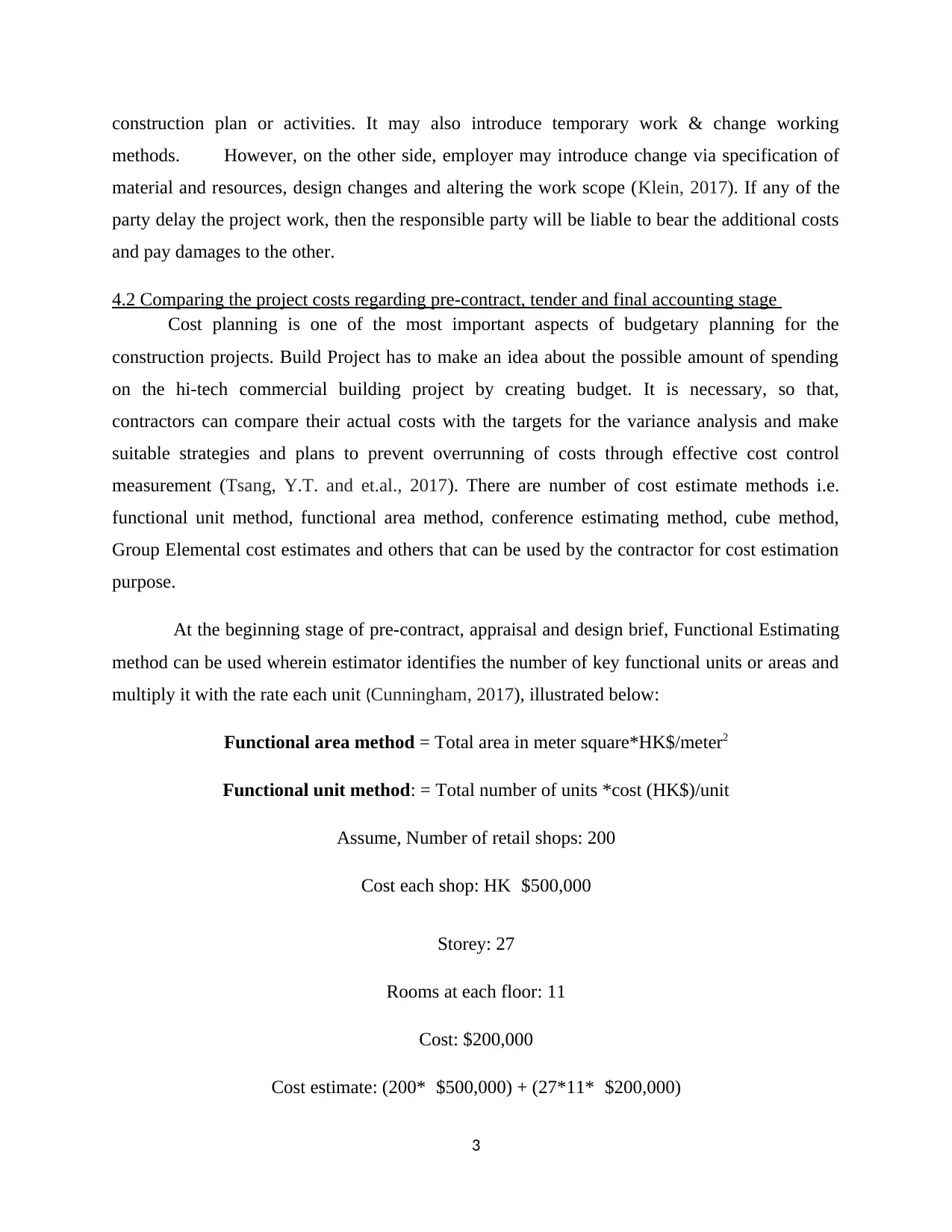
construction plan or activities. It may also introduce temporary work & change working
methods. However, on the other side, employer may introduce change via specification of
material and resources, design changes and altering the work scope (Klein, 2017). If any of the
party delay the project work, then the responsible party will be liable to bear the additional costs
and pay damages to the other.
4.2 Comparing the project costs regarding pre-contract, tender and final accounting stage
Cost planning is one of the most important aspects of budgetary planning for the
construction projects. Build Project has to make an idea about the possible amount of spending
on the hi-tech commercial building project by creating budget. It is necessary, so that,
contractors can compare their actual costs with the targets for the variance analysis and make
suitable strategies and plans to prevent overrunning of costs through effective cost control
measurement (Tsang, Y.T. and et.al., 2017). There are number of cost estimate methods i.e.
functional unit method, functional area method, conference estimating method, cube method,
Group Elemental cost estimates and others that can be used by the contractor for cost estimation
purpose.
At the beginning stage of pre-contract, appraisal and design brief, Functional Estimating
method can be used wherein estimator identifies the number of key functional units or areas and
multiply it with the rate each unit (Cunningham, 2017), illustrated below:
Functional area method = Total area in meter square*HK$/meter2
Functional unit method: = Total number of units *cost (HK$)/unit
Assume, Number of retail shops: 200
Cost each shop: HK $500,000
Storey: 27
Rooms at each floor: 11
Cost: $200,000
Cost estimate: (200* $500,000) + (27*11* $200,000)
3
methods. However, on the other side, employer may introduce change via specification of
material and resources, design changes and altering the work scope (Klein, 2017). If any of the
party delay the project work, then the responsible party will be liable to bear the additional costs
and pay damages to the other.
4.2 Comparing the project costs regarding pre-contract, tender and final accounting stage
Cost planning is one of the most important aspects of budgetary planning for the
construction projects. Build Project has to make an idea about the possible amount of spending
on the hi-tech commercial building project by creating budget. It is necessary, so that,
contractors can compare their actual costs with the targets for the variance analysis and make
suitable strategies and plans to prevent overrunning of costs through effective cost control
measurement (Tsang, Y.T. and et.al., 2017). There are number of cost estimate methods i.e.
functional unit method, functional area method, conference estimating method, cube method,
Group Elemental cost estimates and others that can be used by the contractor for cost estimation
purpose.
At the beginning stage of pre-contract, appraisal and design brief, Functional Estimating
method can be used wherein estimator identifies the number of key functional units or areas and
multiply it with the rate each unit (Cunningham, 2017), illustrated below:
Functional area method = Total area in meter square*HK$/meter2
Functional unit method: = Total number of units *cost (HK$)/unit
Assume, Number of retail shops: 200
Cost each shop: HK $500,000
Storey: 27
Rooms at each floor: 11
Cost: $200,000
Cost estimate: (200* $500,000) + (27*11* $200,000)
3
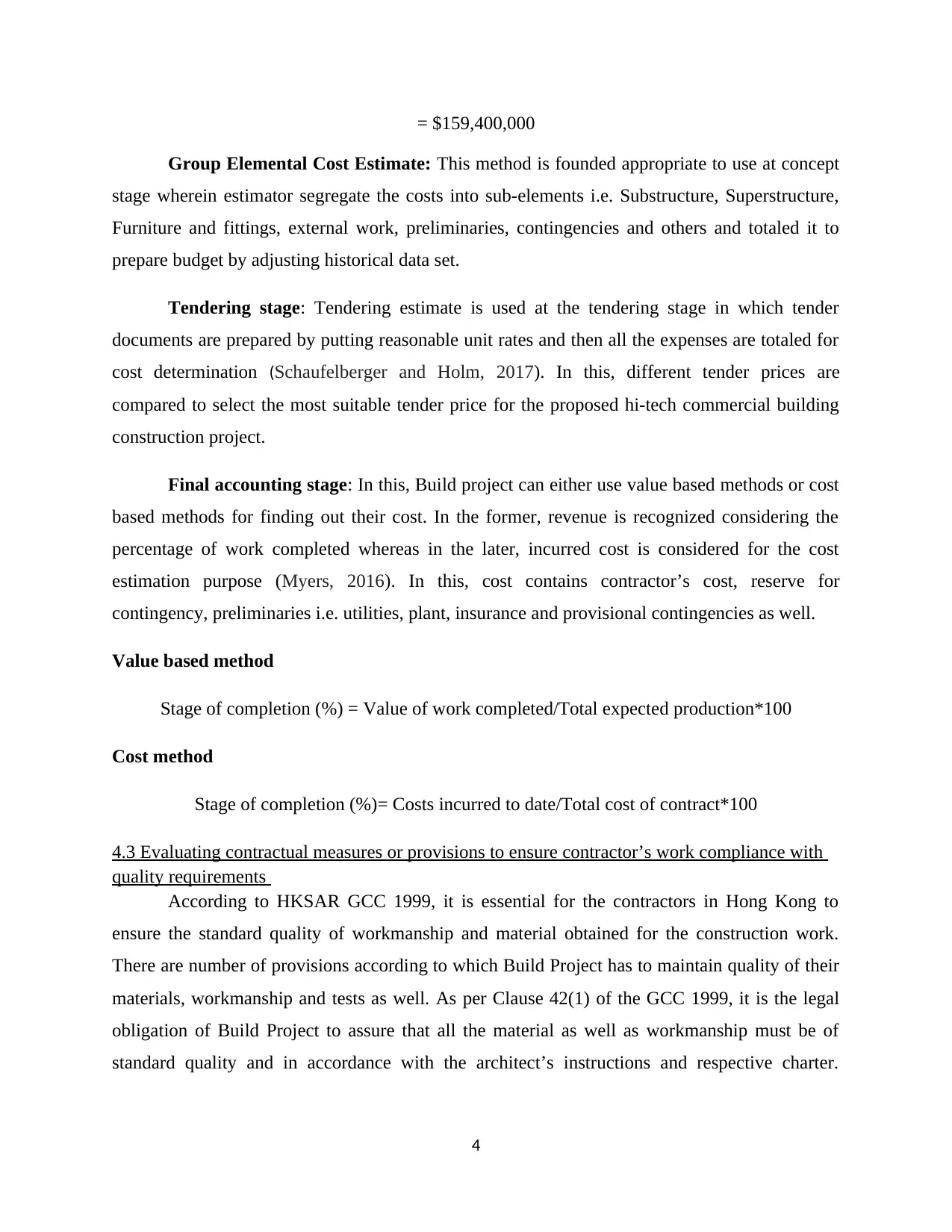
= $159,400,000
Group Elemental Cost Estimate: This method is founded appropriate to use at concept
stage wherein estimator segregate the costs into sub-elements i.e. Substructure, Superstructure,
Furniture and fittings, external work, preliminaries, contingencies and others and totaled it to
prepare budget by adjusting historical data set.
Tendering stage: Tendering estimate is used at the tendering stage in which tender
documents are prepared by putting reasonable unit rates and then all the expenses are totaled for
cost determination (Schaufelberger and Holm, 2017). In this, different tender prices are
compared to select the most suitable tender price for the proposed hi-tech commercial building
construction project.
Final accounting stage: In this, Build project can either use value based methods or cost
based methods for finding out their cost. In the former, revenue is recognized considering the
percentage of work completed whereas in the later, incurred cost is considered for the cost
estimation purpose (Myers, 2016). In this, cost contains contractor’s cost, reserve for
contingency, preliminaries i.e. utilities, plant, insurance and provisional contingencies as well.
Value based method
Stage of completion (%) = Value of work completed/Total expected production*100
Cost method
Stage of completion (%)= Costs incurred to date/Total cost of contract*100
4.3 Evaluating contractual measures or provisions to ensure contractor’s work compliance with
quality requirements
According to HKSAR GCC 1999, it is essential for the contractors in Hong Kong to
ensure the standard quality of workmanship and material obtained for the construction work.
There are number of provisions according to which Build Project has to maintain quality of their
materials, workmanship and tests as well. As per Clause 42(1) of the GCC 1999, it is the legal
obligation of Build Project to assure that all the material as well as workmanship must be of
standard quality and in accordance with the architect’s instructions and respective charter.
4
Group Elemental Cost Estimate: This method is founded appropriate to use at concept
stage wherein estimator segregate the costs into sub-elements i.e. Substructure, Superstructure,
Furniture and fittings, external work, preliminaries, contingencies and others and totaled it to
prepare budget by adjusting historical data set.
Tendering stage: Tendering estimate is used at the tendering stage in which tender
documents are prepared by putting reasonable unit rates and then all the expenses are totaled for
cost determination (Schaufelberger and Holm, 2017). In this, different tender prices are
compared to select the most suitable tender price for the proposed hi-tech commercial building
construction project.
Final accounting stage: In this, Build project can either use value based methods or cost
based methods for finding out their cost. In the former, revenue is recognized considering the
percentage of work completed whereas in the later, incurred cost is considered for the cost
estimation purpose (Myers, 2016). In this, cost contains contractor’s cost, reserve for
contingency, preliminaries i.e. utilities, plant, insurance and provisional contingencies as well.
Value based method
Stage of completion (%) = Value of work completed/Total expected production*100
Cost method
Stage of completion (%)= Costs incurred to date/Total cost of contract*100
4.3 Evaluating contractual measures or provisions to ensure contractor’s work compliance with
quality requirements
According to HKSAR GCC 1999, it is essential for the contractors in Hong Kong to
ensure the standard quality of workmanship and material obtained for the construction work.
There are number of provisions according to which Build Project has to maintain quality of their
materials, workmanship and tests as well. As per Clause 42(1) of the GCC 1999, it is the legal
obligation of Build Project to assure that all the material as well as workmanship must be of
standard quality and in accordance with the architect’s instructions and respective charter.
4
⊘ This is a preview!⊘
Do you want full access?
Subscribe today to unlock all pages.

Trusted by 1+ million students worldwide
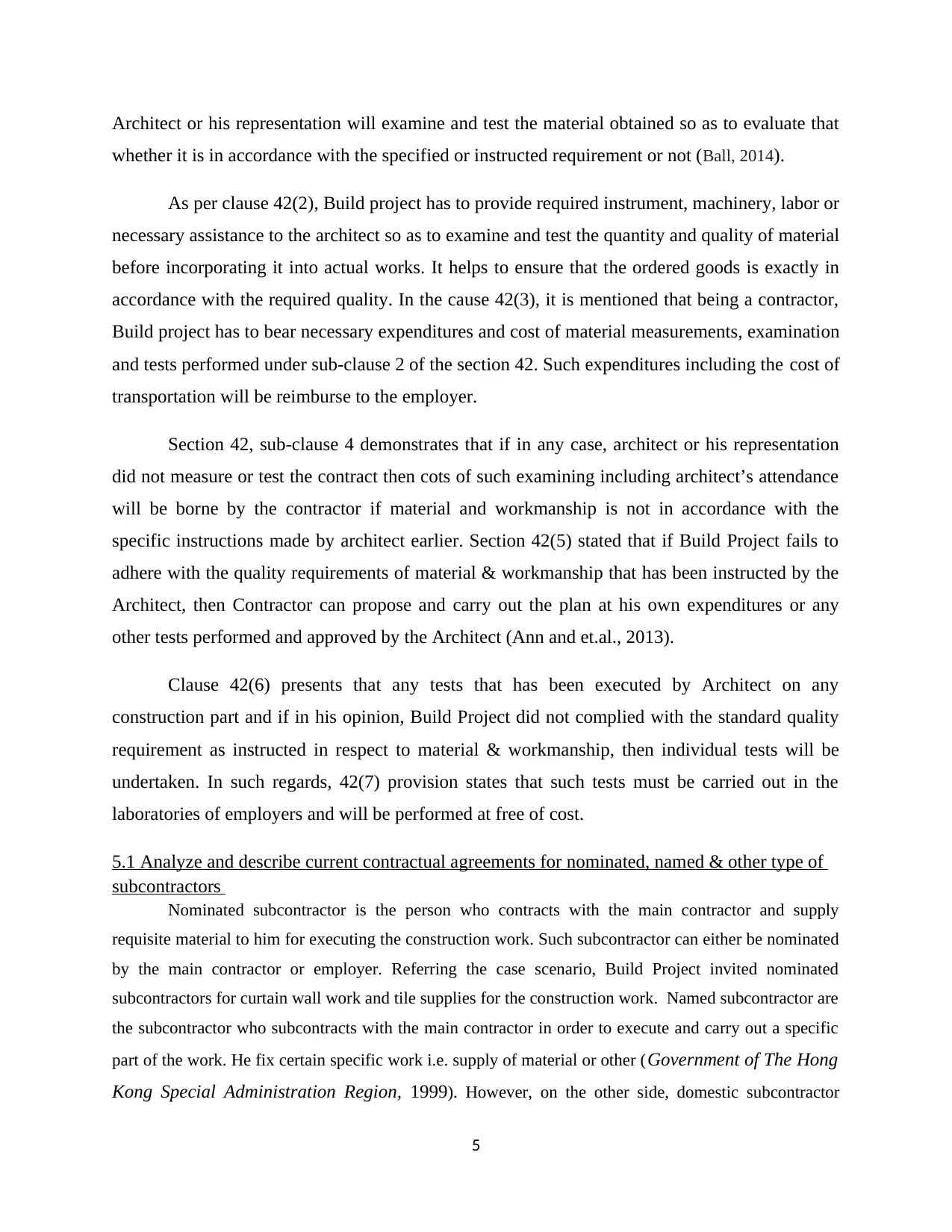
Architect or his representation will examine and test the material obtained so as to evaluate that
whether it is in accordance with the specified or instructed requirement or not (Ball, 2014).
As per clause 42(2), Build project has to provide required instrument, machinery, labor or
necessary assistance to the architect so as to examine and test the quantity and quality of material
before incorporating it into actual works. It helps to ensure that the ordered goods is exactly in
accordance with the required quality. In the cause 42(3), it is mentioned that being a contractor,
Build project has to bear necessary expenditures and cost of material measurements, examination
and tests performed under sub-clause 2 of the section 42. Such expenditures including the cost of
transportation will be reimburse to the employer.
Section 42, sub-clause 4 demonstrates that if in any case, architect or his representation
did not measure or test the contract then cots of such examining including architect’s attendance
will be borne by the contractor if material and workmanship is not in accordance with the
specific instructions made by architect earlier. Section 42(5) stated that if Build Project fails to
adhere with the quality requirements of material & workmanship that has been instructed by the
Architect, then Contractor can propose and carry out the plan at his own expenditures or any
other tests performed and approved by the Architect (Ann and et.al., 2013).
Clause 42(6) presents that any tests that has been executed by Architect on any
construction part and if in his opinion, Build Project did not complied with the standard quality
requirement as instructed in respect to material & workmanship, then individual tests will be
undertaken. In such regards, 42(7) provision states that such tests must be carried out in the
laboratories of employers and will be performed at free of cost.
5.1 Analyze and describe current contractual agreements for nominated, named & other type of
subcontractors
Nominated subcontractor is the person who contracts with the main contractor and supply
requisite material to him for executing the construction work. Such subcontractor can either be nominated
by the main contractor or employer. Referring the case scenario, Build Project invited nominated
subcontractors for curtain wall work and tile supplies for the construction work. Named subcontractor are
the subcontractor who subcontracts with the main contractor in order to execute and carry out a specific
part of the work. He fix certain specific work i.e. supply of material or other (Government of The Hong
Kong Special Administration Region, 1999). However, on the other side, domestic subcontractor
5
whether it is in accordance with the specified or instructed requirement or not (Ball, 2014).
As per clause 42(2), Build project has to provide required instrument, machinery, labor or
necessary assistance to the architect so as to examine and test the quantity and quality of material
before incorporating it into actual works. It helps to ensure that the ordered goods is exactly in
accordance with the required quality. In the cause 42(3), it is mentioned that being a contractor,
Build project has to bear necessary expenditures and cost of material measurements, examination
and tests performed under sub-clause 2 of the section 42. Such expenditures including the cost of
transportation will be reimburse to the employer.
Section 42, sub-clause 4 demonstrates that if in any case, architect or his representation
did not measure or test the contract then cots of such examining including architect’s attendance
will be borne by the contractor if material and workmanship is not in accordance with the
specific instructions made by architect earlier. Section 42(5) stated that if Build Project fails to
adhere with the quality requirements of material & workmanship that has been instructed by the
Architect, then Contractor can propose and carry out the plan at his own expenditures or any
other tests performed and approved by the Architect (Ann and et.al., 2013).
Clause 42(6) presents that any tests that has been executed by Architect on any
construction part and if in his opinion, Build Project did not complied with the standard quality
requirement as instructed in respect to material & workmanship, then individual tests will be
undertaken. In such regards, 42(7) provision states that such tests must be carried out in the
laboratories of employers and will be performed at free of cost.
5.1 Analyze and describe current contractual agreements for nominated, named & other type of
subcontractors
Nominated subcontractor is the person who contracts with the main contractor and supply
requisite material to him for executing the construction work. Such subcontractor can either be nominated
by the main contractor or employer. Referring the case scenario, Build Project invited nominated
subcontractors for curtain wall work and tile supplies for the construction work. Named subcontractor are
the subcontractor who subcontracts with the main contractor in order to execute and carry out a specific
part of the work. He fix certain specific work i.e. supply of material or other (Government of The Hong
Kong Special Administration Region, 1999). However, on the other side, domestic subcontractor
5
Paraphrase This Document
Need a fresh take? Get an instant paraphrase of this document with our AI Paraphraser
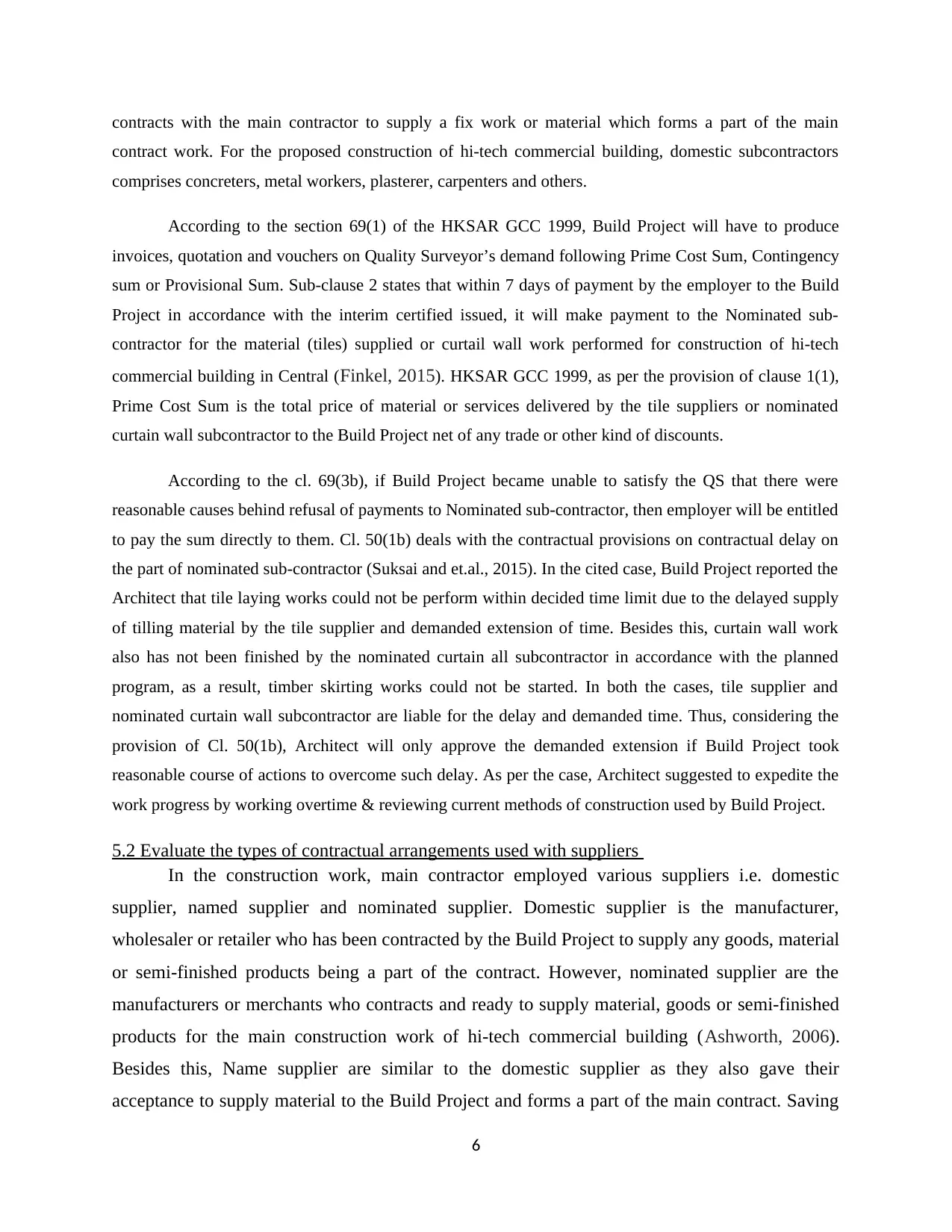
contracts with the main contractor to supply a fix work or material which forms a part of the main
contract work. For the proposed construction of hi-tech commercial building, domestic subcontractors
comprises concreters, metal workers, plasterer, carpenters and others.
According to the section 69(1) of the HKSAR GCC 1999, Build Project will have to produce
invoices, quotation and vouchers on Quality Surveyor’s demand following Prime Cost Sum, Contingency
sum or Provisional Sum. Sub-clause 2 states that within 7 days of payment by the employer to the Build
Project in accordance with the interim certified issued, it will make payment to the Nominated sub-
contractor for the material (tiles) supplied or curtail wall work performed for construction of hi-tech
commercial building in Central (Finkel, 2015). HKSAR GCC 1999, as per the provision of clause 1(1),
Prime Cost Sum is the total price of material or services delivered by the tile suppliers or nominated
curtain wall subcontractor to the Build Project net of any trade or other kind of discounts.
According to the cl. 69(3b), if Build Project became unable to satisfy the QS that there were
reasonable causes behind refusal of payments to Nominated sub-contractor, then employer will be entitled
to pay the sum directly to them. Cl. 50(1b) deals with the contractual provisions on contractual delay on
the part of nominated sub-contractor (Suksai and et.al., 2015). In the cited case, Build Project reported the
Architect that tile laying works could not be perform within decided time limit due to the delayed supply
of tilling material by the tile supplier and demanded extension of time. Besides this, curtain wall work
also has not been finished by the nominated curtain all subcontractor in accordance with the planned
program, as a result, timber skirting works could not be started. In both the cases, tile supplier and
nominated curtain wall subcontractor are liable for the delay and demanded time. Thus, considering the
provision of Cl. 50(1b), Architect will only approve the demanded extension if Build Project took
reasonable course of actions to overcome such delay. As per the case, Architect suggested to expedite the
work progress by working overtime & reviewing current methods of construction used by Build Project.
5.2 Evaluate the types of contractual arrangements used with suppliers
In the construction work, main contractor employed various suppliers i.e. domestic
supplier, named supplier and nominated supplier. Domestic supplier is the manufacturer,
wholesaler or retailer who has been contracted by the Build Project to supply any goods, material
or semi-finished products being a part of the contract. However, nominated supplier are the
manufacturers or merchants who contracts and ready to supply material, goods or semi-finished
products for the main construction work of hi-tech commercial building (Ashworth, 2006).
Besides this, Name supplier are similar to the domestic supplier as they also gave their
acceptance to supply material to the Build Project and forms a part of the main contract. Saving
6
contract work. For the proposed construction of hi-tech commercial building, domestic subcontractors
comprises concreters, metal workers, plasterer, carpenters and others.
According to the section 69(1) of the HKSAR GCC 1999, Build Project will have to produce
invoices, quotation and vouchers on Quality Surveyor’s demand following Prime Cost Sum, Contingency
sum or Provisional Sum. Sub-clause 2 states that within 7 days of payment by the employer to the Build
Project in accordance with the interim certified issued, it will make payment to the Nominated sub-
contractor for the material (tiles) supplied or curtail wall work performed for construction of hi-tech
commercial building in Central (Finkel, 2015). HKSAR GCC 1999, as per the provision of clause 1(1),
Prime Cost Sum is the total price of material or services delivered by the tile suppliers or nominated
curtain wall subcontractor to the Build Project net of any trade or other kind of discounts.
According to the cl. 69(3b), if Build Project became unable to satisfy the QS that there were
reasonable causes behind refusal of payments to Nominated sub-contractor, then employer will be entitled
to pay the sum directly to them. Cl. 50(1b) deals with the contractual provisions on contractual delay on
the part of nominated sub-contractor (Suksai and et.al., 2015). In the cited case, Build Project reported the
Architect that tile laying works could not be perform within decided time limit due to the delayed supply
of tilling material by the tile supplier and demanded extension of time. Besides this, curtain wall work
also has not been finished by the nominated curtain all subcontractor in accordance with the planned
program, as a result, timber skirting works could not be started. In both the cases, tile supplier and
nominated curtain wall subcontractor are liable for the delay and demanded time. Thus, considering the
provision of Cl. 50(1b), Architect will only approve the demanded extension if Build Project took
reasonable course of actions to overcome such delay. As per the case, Architect suggested to expedite the
work progress by working overtime & reviewing current methods of construction used by Build Project.
5.2 Evaluate the types of contractual arrangements used with suppliers
In the construction work, main contractor employed various suppliers i.e. domestic
supplier, named supplier and nominated supplier. Domestic supplier is the manufacturer,
wholesaler or retailer who has been contracted by the Build Project to supply any goods, material
or semi-finished products being a part of the contract. However, nominated supplier are the
manufacturers or merchants who contracts and ready to supply material, goods or semi-finished
products for the main construction work of hi-tech commercial building (Ashworth, 2006).
Besides this, Name supplier are similar to the domestic supplier as they also gave their
acceptance to supply material to the Build Project and forms a part of the main contract. Saving
6
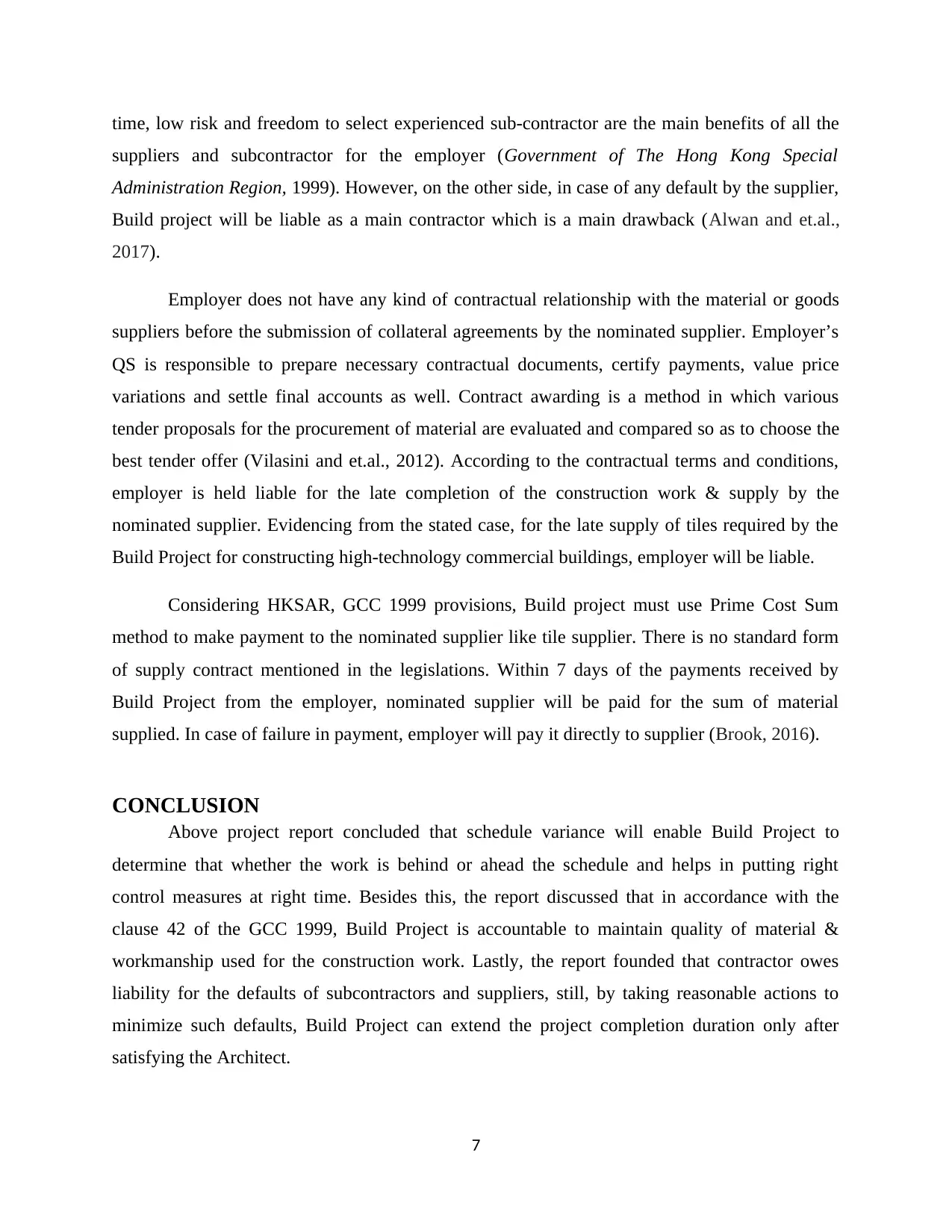
time, low risk and freedom to select experienced sub-contractor are the main benefits of all the
suppliers and subcontractor for the employer (Government of The Hong Kong Special
Administration Region, 1999). However, on the other side, in case of any default by the supplier,
Build project will be liable as a main contractor which is a main drawback (Alwan and et.al.,
2017).
Employer does not have any kind of contractual relationship with the material or goods
suppliers before the submission of collateral agreements by the nominated supplier. Employer’s
QS is responsible to prepare necessary contractual documents, certify payments, value price
variations and settle final accounts as well. Contract awarding is a method in which various
tender proposals for the procurement of material are evaluated and compared so as to choose the
best tender offer (Vilasini and et.al., 2012). According to the contractual terms and conditions,
employer is held liable for the late completion of the construction work & supply by the
nominated supplier. Evidencing from the stated case, for the late supply of tiles required by the
Build Project for constructing high-technology commercial buildings, employer will be liable.
Considering HKSAR, GCC 1999 provisions, Build project must use Prime Cost Sum
method to make payment to the nominated supplier like tile supplier. There is no standard form
of supply contract mentioned in the legislations. Within 7 days of the payments received by
Build Project from the employer, nominated supplier will be paid for the sum of material
supplied. In case of failure in payment, employer will pay it directly to supplier (Brook, 2016).
CONCLUSION
Above project report concluded that schedule variance will enable Build Project to
determine that whether the work is behind or ahead the schedule and helps in putting right
control measures at right time. Besides this, the report discussed that in accordance with the
clause 42 of the GCC 1999, Build Project is accountable to maintain quality of material &
workmanship used for the construction work. Lastly, the report founded that contractor owes
liability for the defaults of subcontractors and suppliers, still, by taking reasonable actions to
minimize such defaults, Build Project can extend the project completion duration only after
satisfying the Architect.
7
suppliers and subcontractor for the employer (Government of The Hong Kong Special
Administration Region, 1999). However, on the other side, in case of any default by the supplier,
Build project will be liable as a main contractor which is a main drawback (Alwan and et.al.,
2017).
Employer does not have any kind of contractual relationship with the material or goods
suppliers before the submission of collateral agreements by the nominated supplier. Employer’s
QS is responsible to prepare necessary contractual documents, certify payments, value price
variations and settle final accounts as well. Contract awarding is a method in which various
tender proposals for the procurement of material are evaluated and compared so as to choose the
best tender offer (Vilasini and et.al., 2012). According to the contractual terms and conditions,
employer is held liable for the late completion of the construction work & supply by the
nominated supplier. Evidencing from the stated case, for the late supply of tiles required by the
Build Project for constructing high-technology commercial buildings, employer will be liable.
Considering HKSAR, GCC 1999 provisions, Build project must use Prime Cost Sum
method to make payment to the nominated supplier like tile supplier. There is no standard form
of supply contract mentioned in the legislations. Within 7 days of the payments received by
Build Project from the employer, nominated supplier will be paid for the sum of material
supplied. In case of failure in payment, employer will pay it directly to supplier (Brook, 2016).
CONCLUSION
Above project report concluded that schedule variance will enable Build Project to
determine that whether the work is behind or ahead the schedule and helps in putting right
control measures at right time. Besides this, the report discussed that in accordance with the
clause 42 of the GCC 1999, Build Project is accountable to maintain quality of material &
workmanship used for the construction work. Lastly, the report founded that contractor owes
liability for the defaults of subcontractors and suppliers, still, by taking reasonable actions to
minimize such defaults, Build Project can extend the project completion duration only after
satisfying the Architect.
7
⊘ This is a preview!⊘
Do you want full access?
Subscribe today to unlock all pages.

Trusted by 1+ million students worldwide

REFERENCES
Books and Journals
Cunningham, T., 2017. Cost Control during The Construction Phase of the Building Project:-The
Consultant Quantity Surveyor’s Perspective.
Klein, H., 2017. Basics Project Planning. Birkhäuser.
Lipke, W., 2017. Forecasting Schedule Variance Using Earned Schedule.
Schaufelberger, J.E. and Holm, L., 2017. Management of construction projects: a constructor's
perspective. Taylor & Francis.
Myers, D., 2016. Construction economics: A new approach. Taylor & Francis.
Tsang, Y.T. and et.al., 2017. Development of an accident modelling in the Hong Kong
construction industry. International Journal of Construction Management. 17(2). pp.124-
131.
Wang, K.C. and et.al., 2016. Applying building information modeling to integrate schedule and
cost for establishing construction progress curves. Automation in Construction. 72(14).
pp.397-410.
Ball, M., 2014. Rebuilding Construction (Routledge Revivals): Economic Change in the British
Construction Industry. Routledge.
Ann, T.W., and et.al., 2013. Impact of construction waste disposal charging scheme on work
practices at construction sites in Hong Kong. Waste management. 33(1). pp.138-146.
Finkel, G., 2015. The economics of the construction industry. Routledge.
'Alwan, Z. and et.al., 2017. Strategic sustainable development in the UK construction industry,
through the framework for strategic sustainable development, using Building Information
Modelling. Journal of Cleaner Production. 140. pp. 349-358.
Vilasini, N. and et.al., 2012. A framework for sub-contractor integration in alliance contracts.
Suksai, S. and et.al., 2015. Delay Factors between Main Contractors and Nominated
Subcontractors in High Rise Buildings in Thailand. GSTF Journal of Engineering
Technology (JET). 3(3). p.104.
8
Books and Journals
Cunningham, T., 2017. Cost Control during The Construction Phase of the Building Project:-The
Consultant Quantity Surveyor’s Perspective.
Klein, H., 2017. Basics Project Planning. Birkhäuser.
Lipke, W., 2017. Forecasting Schedule Variance Using Earned Schedule.
Schaufelberger, J.E. and Holm, L., 2017. Management of construction projects: a constructor's
perspective. Taylor & Francis.
Myers, D., 2016. Construction economics: A new approach. Taylor & Francis.
Tsang, Y.T. and et.al., 2017. Development of an accident modelling in the Hong Kong
construction industry. International Journal of Construction Management. 17(2). pp.124-
131.
Wang, K.C. and et.al., 2016. Applying building information modeling to integrate schedule and
cost for establishing construction progress curves. Automation in Construction. 72(14).
pp.397-410.
Ball, M., 2014. Rebuilding Construction (Routledge Revivals): Economic Change in the British
Construction Industry. Routledge.
Ann, T.W., and et.al., 2013. Impact of construction waste disposal charging scheme on work
practices at construction sites in Hong Kong. Waste management. 33(1). pp.138-146.
Finkel, G., 2015. The economics of the construction industry. Routledge.
'Alwan, Z. and et.al., 2017. Strategic sustainable development in the UK construction industry,
through the framework for strategic sustainable development, using Building Information
Modelling. Journal of Cleaner Production. 140. pp. 349-358.
Vilasini, N. and et.al., 2012. A framework for sub-contractor integration in alliance contracts.
Suksai, S. and et.al., 2015. Delay Factors between Main Contractors and Nominated
Subcontractors in High Rise Buildings in Thailand. GSTF Journal of Engineering
Technology (JET). 3(3). p.104.
8
Paraphrase This Document
Need a fresh take? Get an instant paraphrase of this document with our AI Paraphraser
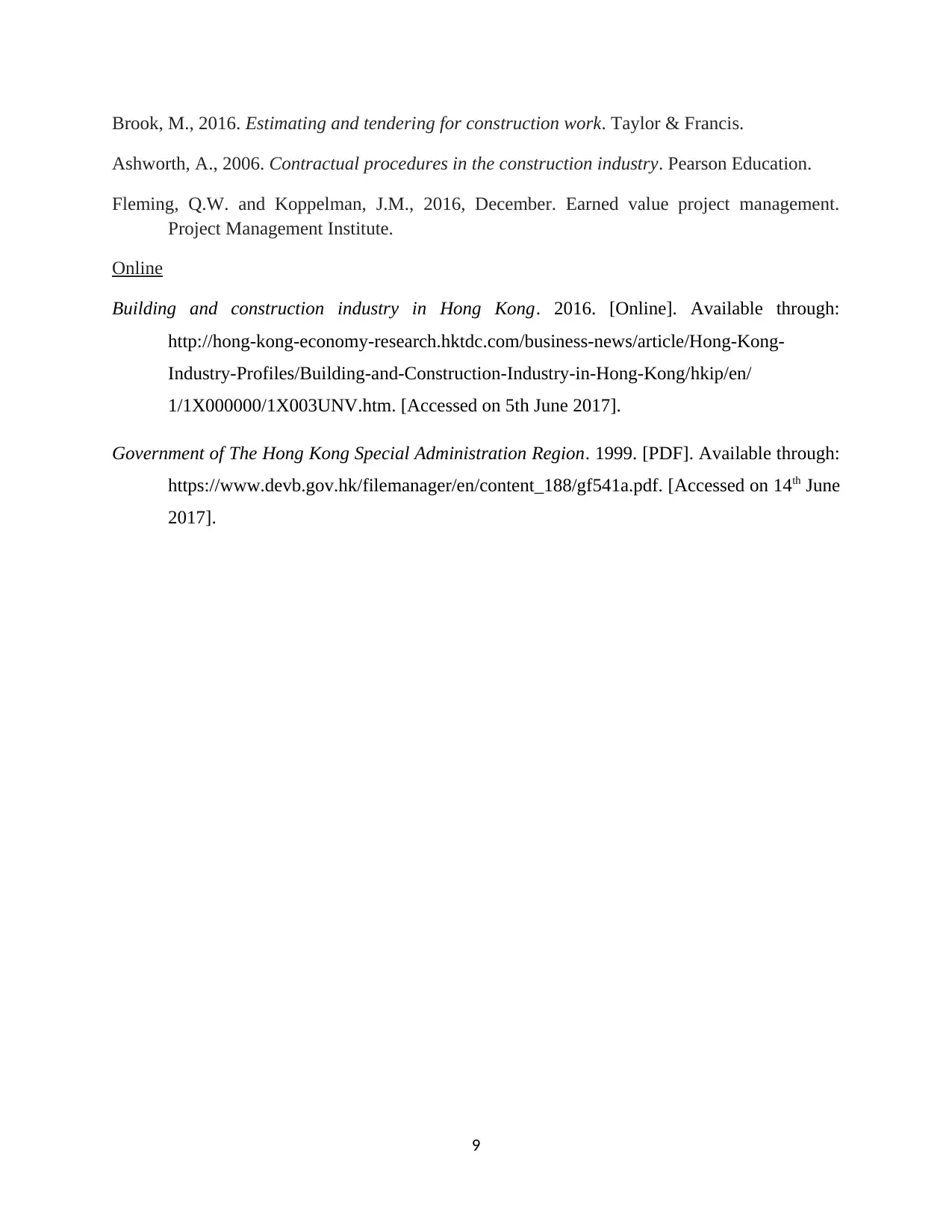
Brook, M., 2016. Estimating and tendering for construction work. Taylor & Francis.
Ashworth, A., 2006. Contractual procedures in the construction industry. Pearson Education.
Fleming, Q.W. and Koppelman, J.M., 2016, December. Earned value project management.
Project Management Institute.
Online
Building and construction industry in Hong Kong. 2016. [Online]. Available through:
http://hong-kong-economy-research.hktdc.com/business-news/article/Hong-Kong-
Industry-Profiles/Building-and-Construction-Industry-in-Hong-Kong/hkip/en/
1/1X000000/1X003UNV.htm. [Accessed on 5th June 2017].
Government of The Hong Kong Special Administration Region. 1999. [PDF]. Available through:
https://www.devb.gov.hk/filemanager/en/content_188/gf541a.pdf. [Accessed on 14th June
2017].
9
Ashworth, A., 2006. Contractual procedures in the construction industry. Pearson Education.
Fleming, Q.W. and Koppelman, J.M., 2016, December. Earned value project management.
Project Management Institute.
Online
Building and construction industry in Hong Kong. 2016. [Online]. Available through:
http://hong-kong-economy-research.hktdc.com/business-news/article/Hong-Kong-
Industry-Profiles/Building-and-Construction-Industry-in-Hong-Kong/hkip/en/
1/1X000000/1X003UNV.htm. [Accessed on 5th June 2017].
Government of The Hong Kong Special Administration Region. 1999. [PDF]. Available through:
https://www.devb.gov.hk/filemanager/en/content_188/gf541a.pdf. [Accessed on 14th June
2017].
9
1 out of 11
Related Documents
Your All-in-One AI-Powered Toolkit for Academic Success.
+13062052269
info@desklib.com
Available 24*7 on WhatsApp / Email
![[object Object]](/_next/static/media/star-bottom.7253800d.svg)
Unlock your academic potential
Copyright © 2020–2025 A2Z Services. All Rights Reserved. Developed and managed by ZUCOL.





